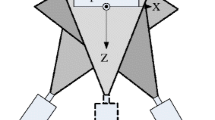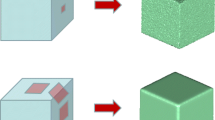Abstract
Increasing interest in the use of digital image correlation (DIC) for full-field surface shape and deformation measurements has led to an on-going need for both the development of theoretical formulae capable of providing quantitative confidence margins and controlled experiments for validation of the theoretical predictions. In the enclosed work, a series of stereo vision experiments are performed in a manner that provides sufficient information for direct comparison with theoretical predictions using formulae developed in Part I. Specifically, experiments are performed to obtain appropriate optimal estimates and the uncertainty margins for the image locations/displacements, 3-D locations/displacements and strains when using the method of subset-based digital image correlation for image matching. The uncertainty of locating the 3-D space points using subset-based pattern matching is estimated by using theoretical formulae developed in Part I and the experimentally defined confidence margins for image locations. Finally, the uncertainty in strains is predicted using formulae that involves both the variance and covariance of intermediate variables during the strain calculation process. Results from both theoretical predictions and the experimental work show the feasibility and accuracy of the predictive formulae for estimating the uncertainty in the stereo-based deformation measurements.
















Similar content being viewed by others
Notes
The number of views of the 12 × 9 calibration grid was in the range 30 ≤ Nviews ≤ 100 when performing the calibration processes for other camera systems and setups. Results indicate Nviews > 30 has a minor effect on the optimal parameter values.
The combination of scale factor and focal length shown in equation (13) in Part I are used in this work in the same way as described previously. Since the scale factors, λx and λy are set equal to 156 pixels/mm in this study, the value provided by the camera manufacturer, only the optimally estimated focal length is shown in Table 2. Direct multiplication of scale factor by focal length corresponds to the term used in Part I.
All image correlation measurements in this work were performed using the commercial code, VIC-3D, developed by Correlated Solutions, Incorporated www.correlatedsolutions.com
Since the specimen is nominally planar, if all coordinates for deformed and undeformed positions are converted to the (x,y,z) system shown in Fig. 1, then there is no need for further transformations to define a planar surface patch.
The strain values in this work are quite small, so that the linear approximation for strain is entirely adequate (e.g., εxx ≈ ∂u/∂x).
Theoretical results based on analyses outlined in Part I for variance in 3D positions were found to be in excellent agreement with predictions provided by Correlated Solutions, Incorporated.
References
Sutton MA, Orteu J-J, Schreier HW (2009) Image correlation for shape motion and deformation measurements: basic concepts, theory and practical applications. Springer, ISBN 978-0-387-78746-6
Sutton MA, McNeill SR, Helm JD, Chao YJ (2000) Advances in two-dimensional and three-dimensional computer vision. In: Rastogi PK (ed) Photomechanics, topics in applied physics. Springer
Li X, Xu W, Sutton MA, Mello M (2006) Nanoscale deformation and cracking studies of advanced metal evaporated magnetic tapes using atomic force microscopy and digital image correlation techniques. Mater Sci Technol 22(7):835–844
Sutton MA, Yan J, Deng X, Cheng CS, Zavattieri P (2007) Three-dimensional digital image correlation to quantify deformation and crack-opening displacement in ductile aluminum under mixed-mode I/III loading. Opt Eng 46(5):051003
Schmidt TE, Tyson J, Galanulis K (2003) Full-field dynamic displacement and strain measurement using advanced 3D image correlation photogrammetry: Part I. Exp Tech 27(3):47–50
Sutton MA, Ke X, Lessner SM, Goldbach M, Yost M, Zhao F, Schreier HW (2008) Strain field measurements on mouse carotid arteries using microscopic three dimensional digital image correlation. J Biomed Mater Res A 84(1):178–190
Sutton MA, McNeill SR, Jang J, Babai M (1988) Effects of subpixel image restoration on digital correlation error estimates. Opt Eng 27(10):870–877
Schreier HW, Braasch JR, Sutton MA (2000) Systematic errors in digital image correlation caused by intensity interpolation. Opt Eng 39(11):2915–2921
Schreier HW (2003) Investigation of two and three-dimensional image correlation techniques with applications in experimental mechanics. Dissertation of University of South Carolina
Bernd J (2004) Practical handbook on image processing for scientific and technical applications. CRC Press
Wang YQ, Sutton MA, Schreier HW (2009) Quantitative error assessment in pattern matching: effects of intensity pattern noise, interpolation, strain and image contrast on motion measurements. Strain 45:160–178
Wang YQ (2010) Error assessment of 3D compute vision. Dissertation of University of South Carolina
Schreier HW, Sutton MA (2002) Systematic errors in digital image correlation due to undermatched subset shape functions. Exp Mech 42(3):303–310
Sutton MA, Yan JH, Tiwari V, Schreier HW, Orteu JJ (2008) The effect of out-of-plane motion on 2D and 3D digital image correlation measurements. Opt Lasers Eng 46:746–757
Acknowledgements
The financial support of Sandia National Laboratory through Sandia Contract PO#551836, the support of Dr. Bruce Lamattina through ARO# W911NF-06-1-0216 and the support provided by Dr. Stephen Smith through NASA NNX07AB46A are gratefully acknowledged. In addition, the research support provided by the Department of Mechanical Engineering at the University of South Carolina is also gratefully acknowledged.
Author information
Authors and Affiliations
Corresponding author
Rights and permissions
About this article
Cite this article
Ke, XD., Schreier, H.W., Sutton, M.A. et al. Error Assessment in Stereo-based Deformation Measurements. Exp Mech 51, 423–441 (2011). https://doi.org/10.1007/s11340-010-9450-3
Received:
Accepted:
Published:
Issue Date:
DOI: https://doi.org/10.1007/s11340-010-9450-3




